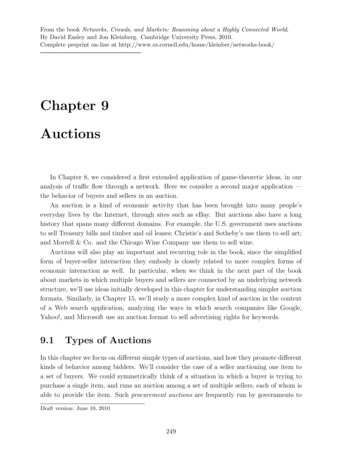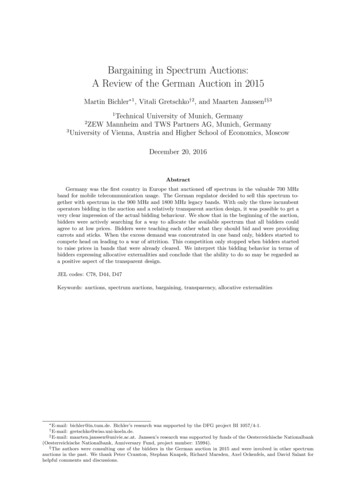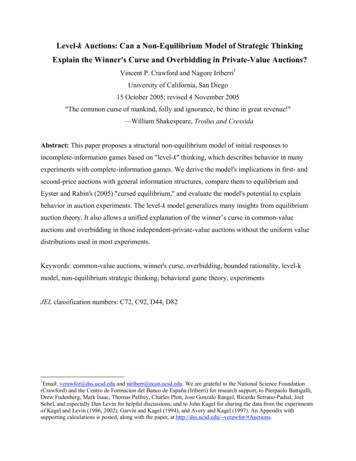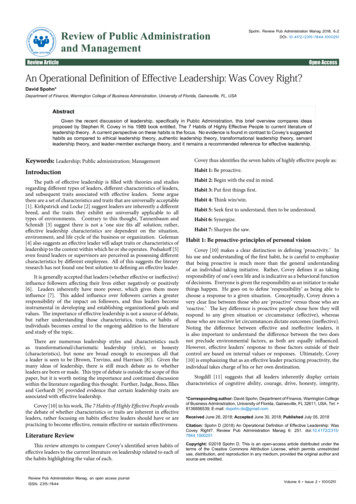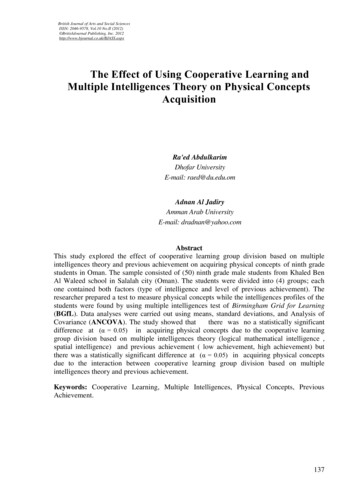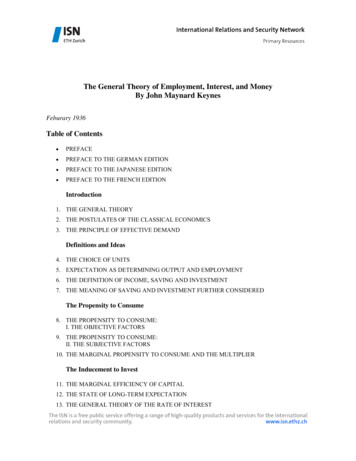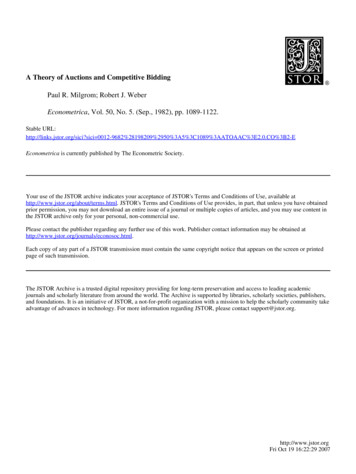
Transcription
A Theory of Auctions and Competitive BiddingPaul R. Milgrom; Robert J. WeberEconometrica, Vol. 50, No. 5. (Sep., 1982), pp. 1089-1122.Stable URL:http://links.jstor.org/sici?sici CO%3B2-EEconometrica is currently published by The Econometric Society.Your use of the JSTOR archive indicates your acceptance of JSTOR's Terms and Conditions of Use, available athttp://www.jstor.org/about/terms.html. JSTOR's Terms and Conditions of Use provides, in part, that unless you have obtainedprior permission, you may not download an entire issue of a journal or multiple copies of articles, and you may use content inthe JSTOR archive only for your personal, non-commercial use.Please contact the publisher regarding any further use of this work. Publisher contact information may be obtained athttp://www.jstor.org/journals/econosoc.html.Each copy of any part of a JSTOR transmission must contain the same copyright notice that appears on the screen or printedpage of such transmission.The JSTOR Archive is a trusted digital repository providing for long-term preservation and access to leading academicjournals and scholarly literature from around the world. The Archive is supported by libraries, scholarly societies, publishers,and foundations. It is an initiative of JSTOR, a not-for-profit organization with a mission to help the scholarly community takeadvantage of advances in technology. For more information regarding JSTOR, please contact support@jstor.org.http://www.jstor.orgFri Oct 19 16:22:29 2007
ECONOMETRICAA THEORY OF AUCTIONS AND COMPETITIVE BIDDING'A model of competitive bidding is developed in which the winning bidder's payoff maydepend upon his personal preferences, the preferences of others, and the intrinsic qualitiesof the object being sold. In this model, the English (ascending) auction generates higheraverage prices than does the second-price auction. Also, when bidders are risk-neutral, thesecond-price auction generates higher average prices than the Dutch and first-priceauctions. In all of these auctions, the seller can raise the expected price by adopting apolicy of providing expert appraisals of the quality of the objects he sells.1. INTRODUCTIONTHEDESIGN AND CONDUCT of auctioning institutions has occupied the attentionof many people over thousands of years. One of the earliest reports of an auctionwas given by the Greek historian Herodotus, who described the sale of women tobe wives in Babylonia around the fifth century B.C. During the closing years ofthe Roman Empire, the auction of plundered booty was common. In China, thepersonal belongings of deceased Buddhist monks were sold at auction as early asthe seventh century A . D . In the United States in the 1980's, auctions account for an enormous volumeof economic activity. Every week, the U.S. Treasury sells billions of dollars ofbills and notes using a sealed-bid auction. The Department of the Interior sellsmineral rights on federally-owned properties at a c t i o nThroughout. the publicand private sectors, purchasing agents solicit delivery-price offers of productsranging from office supplies to specialized mining equipment; sellers auctionantiques and artwork, flowers and livestock, publishing rights and timber. rights,stamps and wine.The large volume of transactions arranged using auctions leads one to wonderwhat accounts for the popularity of such common auction forms as the English, first-price sealed-bid a c t i o n anda c t i o n the, Dutch a c t i o n the, the second'This work was partially supported by the Center for Advanced Studies in Managerial Economicsat Northwestern University, National Science Foundation Grant SES-8001932, Office of NavalResearch Grants ONR-N00-14-79-C-0685 and ONR-N000-14-77-C-0518, and by National ScienceFoundation Grant SOC77-06000-A1 at the Institute for Mathematical Studies in the Social Sciences,Stanford University. We thank the referees for their helpful comments.2These and other historical references can be found in Cassady [2].3 0 n September 30, 1980, U.S. oil companies paid 2.8 billion for drilling rights on 147 tracts in theGulf of Mexico. The three most expensive individual tracts brought prices of 165 million, 162million, and 121 million respectively.4 h Englishe(ascending, progressive, open, oral) auction is an auction with many variants, someof which are described in Section 5. In the variant we study, the auctioneer calls successively higherprices until only one willing bidder remains, and the number of active bidders is publicly known at alltimes.5 h Dutche(descending) auction, which has been used to sell flowers for export in Holland, isconducted by an auctioneer who initially calls for a very high price and then continuously lowers theprice until some bidder stops the auction and claims the flowers for that price.
1090P. R. MILGROM AND R. J. WEBERprice sealed-bid auction.' What determines which form will (or should) be usedin any particular circumstance?Equally important, but less thoroughly explored, are questions about therelationship between auction theory and traditional competitive theory. One mayask: Do the prices which arise from the common auction forms resemblecompetitive prices? Do they approach competitive prices when there are manybuyers and sellers? In the case of sales of such things as securities, mineral rights,and timber rights, where the bidders may differ in their knowledge about theintrinsic qualities of the object being sold, do prices aggregate the diverse bits ofinformation available to the many bidders (as they do in some rational expectations market equilibrium models)?In Section 2, we review some important results of the received auction theory,introduce a new general auction model, and summarize the results of ouranalysis. Section 3 contains a formal statement of our model, and develops theproperties of "affiliated" random variables. The various theorems are presentedin Sections 4-8. In Section 9, we offer our views on the current state of auctiontheory. Following Section 9 is a technical appendix dealing with affiliatedrandom variables.2. AN OVERVIEW OF THE RECEIVED THEORY AND NEW RESULTS82.1. The Independent Private Values ModelMuch of the existing literature on auction theory analyzes the independentprivate values model. In that model, a single indivisible object is to be sold to oneof several bidders. Each bidder is risk-neutral and knows the value of the objectto himself, but does not know the value of the object to the other bidders (this isthe private values assumption). The values are modeled as being independentlydrawn from some continuous distribution. Bidders are assumed to behavecompetitively;9 therefore, the auction is treated as a noncooperative game amongthe bidders."At least seven important conclusions emerge from the model. The first of theseis that the Dutch auction and the first-price auction are strategically equivalent.6The first-price auction is a sealed-bid auction in which the buyer making the highest bid claimsthe object and pays the amount he has bid.h he second-price auction is a sealed-bid auction in which the buyer making the highest bidclaims the object, but pays only the amount of the second highest bid. This arrangement does notnecessarily entail any loss of revenue for the seller, because the buyers in this auction will generallyplace higher bids than they would in the first-price auction.8 more thorough survey of the literature is given by Engelbrecht-Wiggans [4]. A comprehensivebibliography of bidding, including almost 500 titles, has been compiled by Stark and Rothkopf [26].'Situations in which bidders collude have received no attention in theoretical studies, despitemany allegations of collusion, particularly in bidding for timber rights (Mead [14]).'OThe case in which several identical objects are offered for sale with a limit of one item per bidderhas also been analyzed (Ortega-Reichert [22], Vickrey [30]). All of the results discussed below havenatural analogues in that more general setting.Another variation, in which the bidders' private valuations are drawn from a common butunknown distribution, has been treated by Wilson [34].
THEORY OF AUCTIONS1091Recall that in a Dutch auction, the auctioneer begins by naming a very highprice and then lowers it continuously until some bidder stops the auction cndclaims the object for that price. An insight due to Vickrey [29] is that the decisionfaced by a bidder with a particular valuation is essentially static, i.e. the biddermust choose the price level at which he will claim the object if it has not yet beenclaimed. The winning bidder will be the one who chooses the highest level, andthe price he pays will be equal to that amount. This, of course, is also the way thewinner and price are determined in the sealed-bid first-price auction. Thus, thesets of strategies and the mapping from strategies to outcomes are the same forboth auction forms. Consequently, the equilibria of the two auction games mustcoincide.The second conclusion is that-in the context of the private values model-thesecond-price sealed-bid auction and the English auction are equivalent, althoughin a weaker sense than the "strategic equivalence" of the Dutch and first-priceauctions. Recall that in an English auction, the auctioneer begins by solicitingbids at a low price level, and he then gradually raises the price until only onewilling bidder remains. In this setting, a bidder's strategy must specify, for eachof his possible valuations, whether he will be active at any given price level, as afunction of the previous activity he has observed during the course of theauction. However, if a bidder knows the value of the object to himself, he has astraightforward dominant strategy, which is to bid actively until the price reachesthe value of the object to him. Regardless of the strategies adopted by the otherbidders, this simple strategy will be an optimal reply.Similarly, in the second-price auction, if a bidder knows the value of the objectto himself, then his dominant strategy is to submit a sealed bid equal to thatvalue. Thus, in both the English and second-price auctions, there is a uniquedominant-strategy equilibrium. In both auctions, at equilibrium, the winner wilibe the bidder who values the object most highly, and the price he pays will be thevalue of the object to the bidder who values it second-most highly. In that sense,the two auctions are equivalent. Note that this argument requires that eachbidder know the value of the object to himself." If what is being sold is the rightto extract minerals from a property, where the amount of recoverable minerals isunknown, or if it is a work of art, which will be enjoyed by the buyer and theneventually resold for some currently undetermined price, then this equivalenceresult generally does not apply.A third result is that the outcome (at the dominant-strategy equilibrium) of theEnglish and second-price auctions is Pareto optimal; that is, the winner is thebidder who values the object most highly. This conclusion follows immediatelyfrom the argument of the preceding paragraph and, like the first two results, doesnot depend on the symmetry of the model. In symmetric models the Dutch andfirst-price auctions also lead to Pareto optimal allocations."In contrast, the argument concerning the strategic equivalence of the Dutch and first-priceauctions does not require any assumptions about the values to the bidders of various outcomes. Inparticular, it does not require that a bidder know the value of the object to himself.
P. R. MILGROM AND R. J. WEBEROP*(v)IProbability of WinningA fourth result is that in the independent private values model, all four auctionforms lead to identical expected revenues for the seller (Ortega-Reichert [22],Vickrey [30]). This result remained a puzzle until recently, when an application ofthe self-selection approach cast it in a new light (Harris and Raviv [S], Myerson[21], Riley and Samuelson [24]). That approach views a bidder's decision problem (when the strategies of the other bidders are fixed) as one of choosing,through his action, a probability p of winning and a corresponding expectedpayment e(p). (We take e(p) to be the lowest expected payment associated withan action which obtains the object with probability p.) It is important to noticethat, because of the independence assumption, the set of (p, e(p)) pairs that areavailable to the bidder depends only on the rules of the auction and the strategiesof the others, and not on his private valuation of the object.Figure 1 displays a typical bidding decision faced by a bidder who values theprize at v. The curve consists of the set of (p, e(p)) pairs among which he mustchoose.I2 Since the bidder's expected utility from a point (p, e) is v . p - e, hisindifference curves are straight lines with slope v. Let p*(v) denote the optimalchoice of p for a bidder with valuation v. It is clear from the figure that p * mustbe nondecreasing.In Figure 1, the tangency condition is e'(p*(v)) v. Similarly, when theindifference line has multiple points of tangency, a small increase in v causes ajump Ap* in p * and a corresponding jump Ae v . Ap* in e(p*(v)). Hence wecan conclude quite generally that e(p*(v)) e(p*(O)) J;t dp*(t). It then follows that the seller's expected revenue from a bidder depends on the rules of theauction only to the extent that the rules affect either e(p*(O)) or thep* function.Notice, in particular, that all auctions which always deliver the prize to thehighest evaluator have the same p * function for all bidders. That observation,together with the fact that at the dominant-strategy equilibrium the second-priceI2In general, the ( p , e(p))-curve need not be continuous; there may even be values of p for whichno ( p , e(p)) pair is available. However, there will always be a point (0, e(0)) on the curve, withe(0) 5 0, for the bidder is free to abstain from participation. The quantity e(0) will be negative only ifthe seller at times provides subsidies to losing bidders.
THEORY OF AUCTIONS1093auction yields a price equal to the second-highest valuation, leads to the fifthresult.0: Assume that a particular auction mechanism is given, that theTHEOREMindependent private values model applies, and that the bidders adopt strategies whichconsititute a noncooperative equilibrium. Suppose that at equilibrium the bidder whovalues the object most highly is certain to receive it, and that any bidder who valuesthe object at its lowest possible level has an expected payment of zero. Then theexpected revenue generated for the seller by the mechanism is precisely the expectedvalue of the object to the second-highest evaluator.At the symmetric equilibria of the English, Dutch, first-price, and second-priceauctions, the conditions of the theorem are satisfied. Consequently, the expectedselling price is the same for all four mechanisms; this is the so-called "revenueequivalence" result. It should be noted that Theorem 0 has an attractiveeconomic interpretation. No matter what competitive mechanism is used toestablish the selling price of the object, on average the sale will be at the lowestprice at which supply (a single unit) equals demand.The self-selection approach has also been applied to the problem of designingauctions to maximize the seller's expected revenue (Harris and Raviv [8], Myerson [21], Riley and Samuelson [24]). The problem is formulated very generally asa constrained optimal control problem, where the control variables are the pairs(p:(.), ei(pT(0))).As might be expected, the form of the optimal auction dependson the underlying distribution of bidder valuations. One remarkable conclusionemerging from the analysis is this: For many common sample distributionsincluding the normal, exponential, and uniform distributions-the four standardauction forms with suitably chosen reserve' prices or entry fees are optimalauctions.The seventh and last result in this list arises in a variation of the model whereeither the seller or the buyers are risk averse. In that case, the seller will strictlyprefer the Dutch or first-price auction to the English or second-price auction(Harris and Raviv [8], Holt [9], Maskin and Riley [ll], Matthews [13]).2.2. Oil, Gas, and Mineral RightsThe private values assumption is most nearly satisfied in auctions for nondurable consumer goods. The satisfaction derived from consuming such goods isreasonably regarded as a personal matter, so it is plausible that a bidder mayknow the value of the good to himself, and may allow that others could value thegood differently.In contrast, consider the situation in an auction for mineral rights on a tract ofland where the value of the rights depends on the unknown amount of recoverable ore, its quality, its ease of recovery, and the prices that will prevail for theprocessed mineral. To a first approximation, the values of these mineral rights to
1094P. R. MILGROM AND R. J. WEBERthe various bidders can be regarded as equal, but bidders may have differingestimates of the common value.Suppose the bidders make (conditionally) independent estimates of this common value V. Other things being equal, the bidder with the largest estimate willmake the highest bid. Consequently, even if all bidders make unbiased estimates,the winner will find that he had overestimated (on average) the value of therights he has won at auction. Petroleum engineers (Capen, Clapp, and Campbell[I]) have claimed that this phenomenon, known as the winner's curse, is responsible for the low profits earned by oil companies on offshore tracts in the 1960's.The model described above, in which risk-neutral bidders make independentestimates of the common value where the estimates are drawn from a singleunderlying distribution parameterized by V , can be called the mineral rightsmodel or the common value model. The equilibrium of the first-price auction forthis model has been extensively studied (Maskin and Riley [ll], Milgrom [15, 161,Milgrom and Weber [20], Ortega-Reichert [22], Reece [23], Rothkopf [25], Wilson[34]). Among the most interesting results for the mineral rights model are thosedealing with the relations between information, prices, and bidder profits.For example, consider the information that is reflected in the price resultingfrom a mineral rights auction. It is tempting to think that this price cannotconvey more information than was available to the winning bidder, since theprice is just the amount that he bid. This reasoning, however, is incorrect. Sincethe winning bidder's estimate is the maximum among all the estimates, thewinning bid conveys a bound on all the loser's estimates. When there are manybidders, the price conveys a bound on many estimates, and so can be veryinformative. Indeed, let f(x I v) be the density of the distribution of a bidder'sestimate when V v. A property of many one-parameter sampling distributionsis that for v, v,, f(x lo,)/ f(x 1 v2) declines as x increases.I3 If this ratioapproaches zero, then the equilibrium price in a first-price auction with manybidders is a consistent estimator of the value V, even if no bidder can estimate Vclosely from his information alone (Milgrom [15, 161, Wilson [34]). Thus, theprice can be surprisingly effective in aggregating private information.Several results and examples suggest that a bidder's expected profits in amineral rights auction depend more on the privacy of his information than on itsaccuracy as information about V. For example, in the first-price auction a bidderwhose information is also available to some other bidder must have zeroexpected profits at equilibrium (Engelbrecht-Wiggans, Milgrom, and Weber [5],Milgrom [15]). Thus, if two bidders have access to the same estimate of V and athird bidder has access only to some less informative but independent estimate,then the two relatively well-informed bidders must have zero expected profits,but the more poorly-informed bidder may have positive expected profits. Relatedresults appear in Milgrom [15 and 171 and as Theorem 7 of this paper.I3This property is known to statisticians as the monotone likelihood ratio prope,.ty (Tong [27]). Itsusefulness for economic modelling has been elaborated by Milgrom [18].
THEORY OF AUCTIONS10952.3. A General ModelConsider the issues that arise in attempting to select an auction to use in sellinga painting. If the independent private values model is to be applied, one mustmake two assumptions: that each bidder knows his value for the painting, andthat the values are statistically independent. The first assumption rules out thepossibilities: (i) that the painting may be resold later for an unknown price, (ii)that there may be some "prestige" value in owning a painting which is admiredby other bidders, and (iii) that the authenticity of the painting may be in doubt.The second assumption rules out the possibility that several bidders may haverelevant information concerning the painting's authenticity, or that a buyer,thinking that the painting is particularly fine, may conclude that other biddersalso are likely to value it highly. Only if these assumptions are palatable can thetheory be used to guide the seller's choice of an auction procedure. Even in thiscase, however, little guidance is forthcoming: the theory predicts that the fourmost common auction forms lead to the same expected price.Unlike the private values theory, the common value theory allows for statistical dependence among bidders' value estimates, but offers no role for differencesin individual tastes. Furthermore, the received theory offers no basis for choosingamong the first-price, second-price, Dutch, and English auction procedures.In this paper, we develop a general auction model for risk-neutral bidderswhich includes as special cases the independent private values model and thecommon value model, as well as a range of intermediate models which can betterrepresent, for example, the auction of a painting. Despite its generality, themodel yields several testable predictions. First, the Dutch and first-price auctionsare strategically equivalent in the general model, just as they were in the privatevalues model. Second, when bidders are uncertain about their value estimates,the English and second-price auctions are not equivalent: the English auctiongenerally leads to larger expected prices. One explanation of this inequality isthat when bidders are uncertain about their valuations, they can acquire usefulinformation by scrutinizing the bidding behavior of their competitors during thecourse of an English auction. That extra information weakens the winner's curseand leads to more aggressive bidding in the English auction, which accounts forthe higher expected price.A third prediction of the model is that when the bidders' value estimates arestatistically dependent, the second-price auction generates a higher average pricethan does the first-price auction. Thus, the common auction forms can be rankedby the expected prices they generate. The English auction generates the highestprices followed by the second-price auction and, finally, the Dutch and first-priceauctions. This may explain the observation that "an estimated 75 per cent, oreven more, of all auctions in the world are conducted on an ascending-bid basis"(Cassady [2, page 661).Suppose that the seller has access to a private source of information. Further,suppose that he can commit himself to any policy of reporting information thathe chooses. Among the possible policies are: (i) concealment (never report any
1096P. R. MILGROM AND R. J. WEBERinformation), (ii) honesty (always report all information completely), (iii) censoring (report only the most favorable information), (iv) summarizing (report only arough summary statistic), and (v) randomizing (add noise to the data beforereporting).The fourth conclusion of our analysis is that for the first-price, second-price,and English auctions policy, (ii) maximizes the expected price: Honesty is thebest policy.The general model and its assumptions are presented in Section 3. The analysisof the model is driven by the assumption that the bidders' valuations areaffiliated. Roughly, this means that a high value of one bidder's estimate makeshigh values of the others' estimates more likely. This assumption, though restrictive, accords well with the qualitative features of the situations we have described.Sections 4 through 6 develop our principal results concering the second-price,English, and first-price auction procedures.In Section 7, we modify the general model by introducing reserve prices andentry fees. The introduction of a positive reserve price causes the number ofbidders actually submitting bids to be random, but this does not significantlychange the analysis of equilibrium strategies nor does it alter the ranking of thethree auction forms as revenue generators. However, it does change the analysisof information reporting by the seller, because the number of competitors whoare willing to bid at least the reserve price will generally depend on the details ofthe report: favorable information will attract additional bidders and unfavorableinformation will discourage them. The seller can offset that effect by adjustingthe reserve price (in a manner depending on the particular realization of hisinformation variable) so as to always attract the same set of bidders. When this isdone, the information-release results mentioned above continue to hold.When both a reserve price and an entry fee are used, a bidder will participatein the auction if and only if his expected profit from bidding (given the reserveprice) exceeds the entry fee. In particular, he will participate only if his valueestimate exceeds some minimum level called the screening level. The mosttractable case for analysis arises when the "only if" can be replaced by "if andonly if," that is, when every bidder whose value estimate exceeds the screeninglevel participates: we call that case the regular case. The case of a zero entry feeis always regular.For each type of auction we study, any particular screening level x* can beachieved by a continuum of different combinations (r, e) of reserve prices andentry fees. We show that if (r, e) and (7, e) are two such combinations with e 2,and if the auction corresponding to (r, e) is regular, then the auction corresponding to (7,Z) is also regular but generates lower expected revenues than the(r, e)-auction. Therefore, so long as regularity is preserved and the screening levelis held fixed, it pays to raise entry fees and reduce reserve prices.In Section 8, we consider another variation of the general model, in whichbidders are risk-averse. Recall that in the independent private values model with
THEORY OF AUCTIONS1097risk aversion, the first-price auction yields a larger expected price than do thesecond-price and English auctions. In our more general model, no clear qualitative comparison can be made between the first-price and second-price auctions inthe presence of risk aversion, and all that can be generally said about reserveprices and entry fees in the first-price auction is that the revenue-maximizing feeis positive (cf. Maskin and Riley [Ill). With constant absolute risk aversion,however, both the results that the English auction generates higher average pricesthan the second-price auction, and that the best information-reporting policy forthe seller in either of these two auctions is to reveal fully his information, retaintheir validity.3. THE GENERAL SYMMETRIC MODELConsider an auction in which n bidders compete for the possession of a singleobject. Each bidder possesses some information concerning the object up forsale; let X (XI, . . . , X,) be a vector, the components of which are thereal-valued informational variable ' (or value estimates, or signals) observed bythe individual bidders. Let S (S,, . . . , S,) be a vector of additional realvalued variables which influence the value of the object to the bidders. Some ofthe components of S might be observed by the seller. For example, in the sale ofa work of art, some of the components may represent appraisals obtained by theseller, while other components may correspond to the tastes of art connoisseursnot participating in the auction; these tastes could affect the resale value of theobject.The actual value of the object to bidder i-which may, of course, depend onvariables not 'observed by him at the time of the auction-will be denoted byq. ui(S,X). We make the following assumptions:1: There is a function u on Rm " such that for all i, u,(S,X)ASSUMPTIONu(S,X,, {Xj)jzi). Consequently, all of the bidders' valuations depend on S inthe same manner, and each bidder's valuation is a symmetric function of theother bidders' signals. ASSUMPTION2: The function u is nonnegative, and is continuous and nondecreasing in its variables.ASSUMPTION3: For each i, E [ q] co.I4To represent a bidder's information by a single real-valued signal is to make two substantiveassumptions. Not only must his signal be a sufficient statistic for all of the information he possessesconcerning the value of the object to him, it must also adequately summarize his informationconcerning the signals received by the other bidders. The derivation of such a statistic from severalseparate pieces of information is in general a difficult task (see, for example, the discussion inEngelbrecht-Wiggans and Weber [7]). It is in the light of these difficulties that we choose to view eachXi as a "value estimate," which may be correlated with the "estimates" of others but is the only pieceof information available to bidder i.
1098P. R. MILGROM AND R. J. WEBERBoth the private values model and the common value model involve valuationsof this form. In the first case, m 0 and each Xi; in the second case, m 1and each y. S , .Thro
30n September 30, 1980, U.S. oil companies paid 2.8 billion for drilling rights on 147 tracts in the Gulf of Mexico. The three most expensive individual tracts brought prices of 165 million, 162 million, and 121 million respectively. 4 heEnglish (ascending, progressive, o
